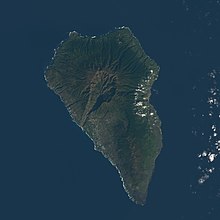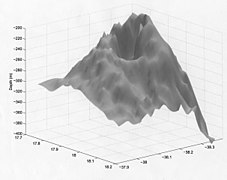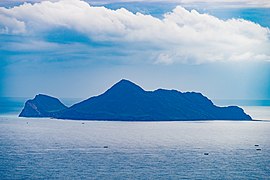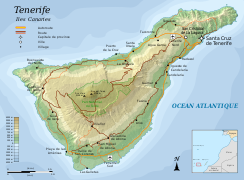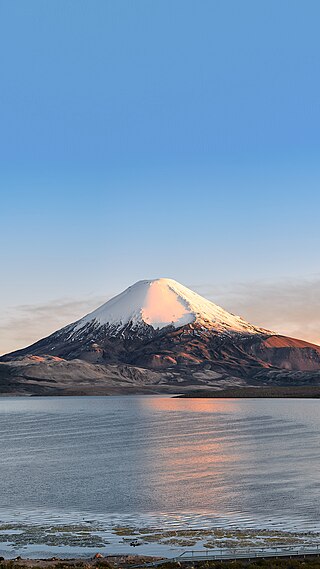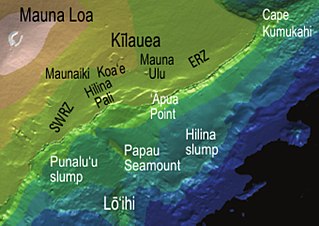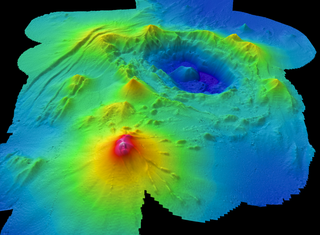Model by Ward and Day 2001
Ward and Day 2001 estimated that the unstable part of Cumbre Vieja would be at least 15 kilometres (9.3 mi) wide in north–south direction. In light of the behaviour of other documented sector collapses such as at Mount St. Helens, the headscarp of the unstable part of Cumbre Vieja is likely 2–3 kilometres (1.2–1.9 mi) east from the 1949 fault and the toe of the sector lies at 1–3 kilometres (0.62–1.86 mi) depth below sea level. Bathymetric observations west of La Palma support this interpretation. They had not enough information with which to estimate the thickness of the block but assumed that it would have a volume of about 150–500 cubic kilometres (36–120 cu mi) and the shape of a wedge, comparable to the Cumbre Nueva giant landslide 566,000 years ago also on La Palma.
The authors used linear wave theory to estimate the tsunami induced by the simulated Cumbre Vieja. They used a scenario of a collapse of 500 cubic kilometres (120 cu mi) that moves at a rate of about 100 metres per second (330 ft/s) on top of a layer of mud or landslide breccia, which lubricate its movement, and eventually spreads 60 kilometres (37 mi) to cover a jug-shaped area of 3,500 square kilometres (1,400 sq mi). Ignoring that the landslide excavates part of the flank of Cumbre Vieja, thus assuming that it does not contribute to any tsunami generation, they estimated the following timing of the tsunami:
- 2 Minutes: A 900 metres (3,000 ft) thick dome of water rises above the landslide.
- 5 Minutes: The dome collapses to a height of 500 metres (1,600 ft) as it advances by 50 kilometres (31 mi); additionally, wave valleys form.
- 10 Minutes: The landslide is now over. Waves reaching heights of 400–600 metres (1,300–2,000 ft) hit the three western Canary Islands.
- 15–60 Minutes: 50–100 metres (160–330 ft) high waves hit Africa. A 500 kilometres (310 mi) wide train of waves advances across the Atlantic.
- 3–6 Hours: The waves hit South America and Newfoundland, reaching heights of 15–20 metres (49–66 ft) and 10 metres (33 ft), respectively. Spain and England are partially protected by La Palma, thus tsunami waves there only reach 5–7 metres (16–23 ft).
- 9 Hours: Waves 20–25 metres (66–82 ft) approach Florida; they are not expected to grow farther as they hit the coast.
France and the Iberian Peninsula would be affected as well. Further, the authors concluded that the size of the tsunami roughly scales with the product of the landslide speed and its volume. They suggested that traces of past such tsunamis may be found in the southeastern United States, on the continental shelf, in northeast Brazil, in the Bahamas, western Africa.
Later models
Mader 2001 employed a shallow water code that includes friction and the Coriolis force. Assuming shallow-water behaviour of the wave even with runup the eventual tsunami heights in the US and the Caribbean would not exceed 3 metres (9.8 ft) and in Africa and Europe it would not be higher than 10 metres (33 ft). Mader 2001 also estimated that dispersion along the US coast could reduce tsunami amplitude to less than 1 metre (3 ft 3 in).
Gisler, Weaver and Gittings 2006 used public domain bathymetric information and the so-called "SAGE hydrocode" to simulate the tsunami stemming from variously shaped landslides. The landslides generate a single wave that eventually detaches from the landslide as the latter slows down. The waves have shorter wavelengths and periods than teletsunamis and thus do not spread as effectively as the latter away from the source and decay away roughly with the inverse of the distance. Such tsunamis would be a greater danger to the Canary Islands, the eastern Lesser Antilles, Iberia, Morocco and northeastern South America than to North America where they would be only a few centimetres high.
Løvholt, Pedersen and Gisler in 2008 published another study that employed the worst-case landslide scenario of Ward and Day 2001, but used hydrodynamic modelling that accounts for dispersion, non-linear effects and the deformation of the landslide material itself to simulate waves generated by such a collapse. In this model, the landslide had a volume of 375 cubic kilometres (90 cu mi) and a maximum speed of 190 metres per second (620 ft/s). It generates a high leading wave that eventually separates from the landslide, while turbulent flow behind the slide generates lower waves. Overall, a complex wave field develops with a sickle-shaped front wave that is over 100 metres (330 ft) high when it reaches a radius of 100 kilometres (62 mi). The waves do not decay at a constant rate with distance, with the crestal wave decaying slightly faster than 1/distance while the trailing wave decays slightly more slowly. Thus at distance the trailing waves can become higher than the leading wave, especially the waves propagating west display this behaviour. Undulating bores also develop, a factor not commonly considered in tsunami models.
In the Løvholt, Pedersen and Gisler 2008 model, the impact in the Canary Islands would be quite severe, with the tsunami reaching heights of over 10–188 metres (33–617 ft), threatening even inland valleys and towns and hitting the two largest cities of the islands (Santa Cruz and Las Palmas) badly. The impact in Florida would not be as severe as in the Ward and Day 2001 model by a factor of 2–3 but wave heights of several metres would still occur around the North Atlantic. Off the US coast, wave amplitude would reach 9.6 metres (31 ft).
Abadie et al. 2009 simulated both the most realistic landslide geometry and the tsunamis that would result from it near its source. [59] They concluded that most realistic volumes would be 38–68 cubic kilometres (9.1–16.3 cu mi) for a small collapse and 108–130 cubic kilometres (26–31 cu mi) for a large collapse. [60] The initial height of the wave depends strongly on the viscosity of the landslide and can exceed 1.3 kilometres (0.81 mi). [61]
Løvholt, Pedersen and Glimsdal 2010 noted that landslide-generated tsunamis can have a leading wave smaller than following waves, requiring a dispersive wave model. They simulated inundation in Cadiz resulting from a 375 cubic kilometres (90 cu mi) collapse at La Palma. The found runup of about 20 metres (66 ft) and the possible development of undular bores.
Abadie, Harris and Grilli 2011 employed three-dimensional simulations with the hydrodynamic simulator "THETIS" to reproduce the tsunamis induced by failures of 20 cubic kilometres (4.8 cu mi), 40 cubic kilometres (9.6 cu mi), 80 cubic kilometres (19 cu mi) and 450 cubic kilometres (110 cu mi). These volumes were taken from studies on the stability of La Palma's western flank, while the 450 cubic kilometres (110 cu mi) reflects worst-case scenarios from earlier tsunami studies at Cumbre Vieja. The landslide is directed southwestward and induces a wave train, with the 80 cubic kilometres (19 cu mi) collapse having a maximum wave height of 80 metres (260 ft). At El Hierro the tsunami can shoal and rise to a height of 100 metres (330 ft), while the wave train surrounds La Palma and continues eastward with a height of 20–30 metres (66–98 ft).
Zhou et al. 2011 used numerical simulations to model various tsunamis, including a scenario resulting from a mass failure at La Palma. It assumes a smaller volume of 365 cubic kilometres (88 cu mi) as the collapse hits only the western flank and does not assume a southwest-directed propagation direction, thus increasing the hazard to the US coast. The resulting tsunami approaches the US coast between 6–8 hours after the collapse, in a north-to-south fashion. Waves grow due to shoaling as they approach the continental shelf but later decline due to increased bottom friction and eventually reach heights of 3–10 metres (9.8–32.8 ft) when they come ashore. The impact of undular bore formation on runup is unclear.
Abadie et al. 2012 simulated both the development of waves using dispersive models that include non-linear effects, and the behaviour of the landslide generating them through slope stability and material strength models. They considered both volumes of 38–68 cubic kilometres (9.1–16.3 cu mi), obtained from research on the stability of the flank of Cumbre Vieja, as well as volumes of 500 cubic kilometres (120 cu mi) as hypothesized by the original Ward and Day 2001 study. The slide has a complex acceleration behaviour and most of the waves are formed during a short period early in the slide where the Froude number briefly exceeds 1; the initial wave can reach a height of 1.3 kilometres (0.81 mi)–0.8 kilometres (0.50 mi) and eventually wave trains are formed, which are diffracted around the southern tip of La Palma and go on to hit the other Canary Islands. With increasing volume of the slides, the wavelength becomes shorter and the amplitude higher, yielding steeper waves. Abadie et al. 2012 estimated a fast decay of the waves with distance but cautioned that since their model was not appropriate to use for simulating far-field wave propagation the decay may be exaggerated. In the Canary Islands, inundation would reach a height of 290 metres (950 ft) on La Palma; even for a 80 cubic kilometres (19 cu mi) slide would reach heights of 100 metres (330 ft) in the city of Santa Cruz de La Palma (population 18,000) while the largest city of La Palma (Los Llanos de Aridane, population 20,000) may be spared. The waves would take approximately one hour to propagate through the archipelago, and important cities in the entire Canary Islands would be hit by substantial tsunamis irrespective of the landslide size.
Tehranirad et al. 2015 modelled the impact both of a worst-case 450 cubic kilometres (110 cu mi) landslide and of a more realistic 80 cubic kilometres (19 cu mi) collapse on Ocean City, Maryland, the surrounding area, Europe, Africa and the Canary Islands, using the "THETIS" and "FUNWAVE-TVD" hydrodynamical models. They found that for a larger volume, the leading wave is both larger and forms farther away from the island. For a volume of 450 cubic kilometres (110 cu mi), the tsunami hits Africa after 1–2 hours, followed by Europe between 2–3 hours, the Central Atlantic between 4–5 hours and the US continental shelf between 7–9 hours. At the continental shelf, the wave train slows down and the number of main waves changes. Bathymetry, such as the presence of submarine topography, alters the behaviour of the wave. In the 450 cubic kilometres (110 cu mi) scenario after slightly over 8 hours from collapse tsunami waves reach the areas offshore the US coast, where their height decays as they traverse the continental shelf. The eventual wave heights at the 5 metres (16 ft) depth contour are about 0–2 metres (0.0–6.6 ft) for the 80 cubic kilometres (19 cu mi) collapse and 1–5 metres (3 ft 3 in – 16 ft 5 in) for the 450 cubic kilometres (110 cu mi) collapse; impact is worst in North Carolina but also New York and Florida are impacted even if refraction around the Hudson River Canyon mitigates the impact in New York City. In Europe, tsunami waves arrive after 1–2 hours; even with a smaller collapse of 80 cubic kilometres (19 cu mi) impact around Porto and Lisbon is severe with waves of 5 metres (16 ft) height, as Europe is closer to La Palma.
Abadie et al. 2020 repeated their 2012 simulations using a model which incorporates viscous behaviour to obtain wave heights in the Atlantic, the Caribbean Sea and Western Europe for landslides with a volume of 20 cubic kilometres (4.8 cu mi), 40 cubic kilometres (9.6 cu mi) and 80 cubic kilometres (19 cu mi). This simulation yields a lower initial wave height (80 metres (260 ft) for the 80 cubic kilometres (19 cu mi) landslide) and a flatter profile of the initial water level disturbance. Wave heights reach 0.15 metres (5.9 in) in the Bay of Biscay, 0.75 metres (2 ft 6 in) south of Portugal,0.4–0.25 metres (1 ft 3.7 in – 9.8 in) along French coasts, 0.75–0.5 metres (2 ft 6 in – 1 ft 8 in) at Guadeloupe, all for the 80 cubic kilometres (19 cu mi) case. Tsunami heights at Agadir, Essaouira and Sufi exceed 5 metres (16 ft), at Lisbon, Coruna, Porto and Vigo about 2 metres (6 ft 7 in) and along parts of the French coasts 1 metre (3 ft 3 in); in Guadeloupe even a small landslide (20 cubic kilometres (4.8 cu mi)) can lead to widespread inundation.
Ward and Day 2006 indicated that the combined effects of several wave trains may amplify the tsunami impact over that of a single wave. [101] Research by Frohlich et al. 2009 on boulders emplaced on Tongatapu endorsed the hypothesis of large landslide-induced tsunamis [102] and Ramalho et al. 2015 identified evidence of a megatsunami, implying a single step collapse, caused by the collapse of Fogo volcano in the Cape Verde islands. [103]
